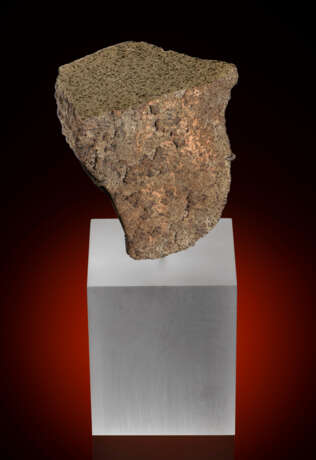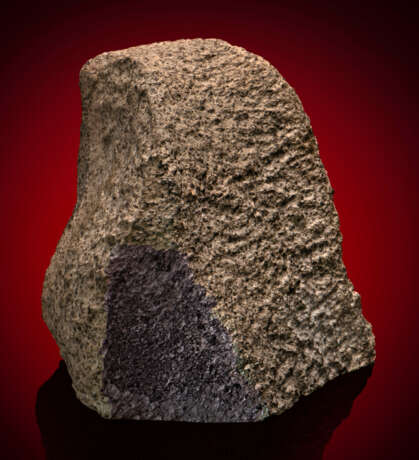ID 716436
Lot 51 | NWA 13885 — LARGE SPECIMEN OF MARS
Estimate value
$ 120 000 – 180 000
As is the case with the Moon, specimens of Mars are among the most exotic substances on Earth with less than 300 kg (650 lbs) known to exist. The delivery mechanism to Earth was an asteroid impact on Mars that ejected material off the Martian surface that found its way into an Earth-crossing orbit. The determination of Martian origin is the result of research conducted by hundreds of scientists throughout the world.
There was an exotic group of enigmatic meteorites that shared numerous characteristics which indicated it formed on a planetary body — but clearly not from Earth. It was believed they were most likely Martian as the escape velocity required to jettison rocks off the Venusian surface is much greater than that of Mars. The long-believed link to Mars was speculative until 1983, when it was found that the abundances of noble gases within melt pockets closely resembled noble gases in the Martian atmosphere measured on the Martian surface by NASA’s Viking landers in 1976. And then in 1995 was the historic study published in Science entitled “Signatures of the Martian Atmosphere in Glass of the Zagami Meteorite”.
This specimen was confirmed as being Martian by the Director of the Institute of Meteoritics, Dr. Carl Agee, who is among the world’s foremost experts in the classification of Martian samples.
This single curvilinear mass features patches of fusion crust on a smoothly textured tan-hued surface accented by the stippling of black grains. The cut and polished surface reveals coarse crystals with orange-brown olivine phenocrysts set in a light green-brown groundmass. Prominent veins of shock melt are in evidence, and the presence of Martian atmosphere can be confidently inferred. This meteorite is primarily composed of pyroxene, olivine, ilmenite, chromite, troilite — the last of which is extremely rare on Earth — and the impact glass maskelynite, which is unknown to occur on Earth except in meteorites. Accompanied by a custom armature, this is a splendid specimen of the planet Mars. Modern cutting. (For a view of what NWA 13885 looks like under a microscope, see the next lot.)
Christie's would like to thank Dr. Alan E. Rubin at the Department of Earth, Planetary, and Space Sciences, University of California, Los Angeles for his assistance in preparing this catalogue.
The analysis of this meteorite was led by Dr. Carl Agee, whose findings underwent peer review by the Nomenclature Committee of the Meteoritical Society. The analysis and classification was published in the 110th edition of the Meteoritical Bulletin.
159 x 136 x 75mm (6.25 x 5.33 x 3 in.) and 1.909 kg (4.25 lbs)
| Category: | Martian meteorite |
|---|
| Category: | Martian meteorite |
|---|
| Address of auction |
CHRISTIE'S 8 King Street, St. James's SW1Y 6QT London United Kingdom | |
|---|---|---|
| Preview |
| |
| Phone | +44 (0)20 7839 9060 | |
| Buyer Premium | see on Website | |
| Conditions of purchase | Conditions of purchase |




